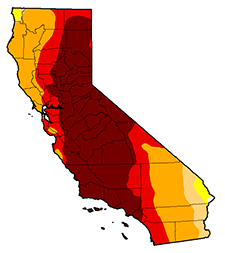The face of golf in California is about to change - forever.
 In response to a directive last month from Gov. Jerry Brown, the California State Water Resources Control Board approved on May 5, measures designed to reduce urban water use statewide by 25 percent through June 2016.
In response to a directive last month from Gov. Jerry Brown, the California State Water Resources Control Board approved on May 5, measures designed to reduce urban water use statewide by 25 percent through June 2016.To meet that goal, the CSWRCB has placed each of the state's 411 urban water suppliers into an 8-tier system, each with different conservation standards. Reductions will range from 8 to 36 percent of 2013 water use figures, depending on per-capita use within each district. For individual users within districts, cutbacks ultimately will be determined by local suppliers.
The rule gives water suppliers a wide berth on how to interpret and implement the rule - as long as their prescribed numbers are achieved. Suppliers can set different reduction standards for different users within the same district and can develop and implement their own contingency plans to help individual users meet localized needs.
For example, the San Jose Water Co., one of the state's largest water suppliers, is in Tier 5, which means that during the next year it must reduce the amount of water it delivers to its customers by 20 percent compared with its 2013 use data. How it reaches that number is up to the water company. Some customers might be asked to save less than 20 percent, while some might be asked to save more. It is largely expected that customers who already have exhibited low-use practices will be asked to reduce their use by a lesser percentage and those with higher per-capita use rates will get hit hardest.
That same latitude applies to all 411 urban water suppliers throughout the state.

Mike Huck, a former golf course superintendent in Southern California and one of the state's leading irrigation consultants and water experts, expects some golf courses might be told to reduce water use by as much as 40 percent.
"The reasoning is the only available water savings are primarily going to come from outdoor landscape irrigation," Huck said. "There isn't much water left to be saved indoors due to water-saving appliances like low gallons-per-flush toilets, low gallons-per-wash clothes washers, dishwashers and low flow shower heads and faucet aerators."
Superintendents still unsure of what the new rule means to them are urged to contact their water supplier.
Californians get their potable water from several sources, including the Colorado River, local groundwater and recycled water from water-treatment plants. And then there is the State Water Project, which channels surface water from sources such as Sierra Nevada snowpack to provide water for nearly 70 percent of all Californians. The project is a system of 700 miles of canals, aqueducts and pipelines that channel water from 34 reservoirs to more the 25 million users throughout the state, including large metropolitan areas like Los Angeles and San Francisco.
With California entrenched in a four-year drought, Brown has pleaded with residents to voluntarily conserve water use.
Some took those pleas seriously. Golf course superintendent Steve Agin has cut water use at Ruby Hill Golf Club in Pleasanton, east of the San Francisco Bay area, by more than 20 percent since then.
"It wasn't mandatory," Agin said. "As a superintendent, I use the bucket analogy, and there is only so much water in the bucket before it runs out."
Not everyone was as proactive. According to the CSWRCB, voluntary cutbacks resulted in a savings of only 3 percent statewide in March, far below what state officials had hoped for. With no end to the drought in site - some reports had Sierra Nevada snowpack this past winter at 5 percent of normal - Brown decided it was time to get serious.
On April 1 he announced a mandate that would result in the state's cumulative reduction of water use by 25 percent through next June and threw the ball into the water control board's court to develop and implement a plan that would make that directive achievable.
Since the 25 percent-reduction rule went into effect May 5, many superintendents around the state have been thrust into panic mode as they wait to see how the rule will affect them.
Since the 25 percent-reduction rule went into effect May 5, many superintendents around the state have been thrust into panic mode as they wait to see how the rule will affect them...
A day after the plan was approved, Craig Kessler, director of governmental affairs for the Southern California Golf Association and another of the state's experts on golf course water issues, was meeting with operators of four golf courses in Orange County who are nervous about how they will be affected.
The rule applies to well water use also, regulation of which was noticeably absent in previous water-conservation efforts, with the rule stating: "Commercial, Industrial and Institutional properties that are not served by a water supplier (or are self-supplied, such as by a groundwater well) also must either reduce water use by 25 percent or restrict outdoor irrigation to no more than two days per week. No reporting is required but these properties must maintain documentation of their water use and practices."
While the CSWRCB is responsible for implementing the governor's directive, penalizing those who fail to comply with the order is up to the individual water districts. And they have a wide range of discretion in levvying fines.
Cutbacks Those utilizing recycled water are exempt from the reduction rule, but that doesn't mean they are not feeling the effects of the drought.
Bob Zoller of Monterey Peninsula Country Club and superintendents from six other courses in Pebble Beach, are approved to draw as much as a combined 2.5 million gallons of treated water per day from the Forest Lake Reservoir in Pebble Beach. But conservation efforts on the Monterey Peninsula, the water utility there is able to produce only 1.3 million gallons per day.
"Golf is at a crossroads in so many areas," Zoller said. "Out here, water is more important than it is in some other areas. It's difficult at this point to look down the road and see what is going to happen."
This is part of a multi-part series of golf and water in California.

